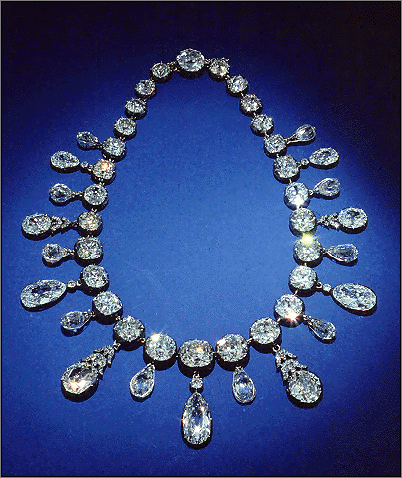
The general Diamond Necklace was given to general Bonaparte's second wife, the Archduchess Marie Louise of Austria. He married her but two months of divorcing Empress Joséphine, under the grounds that she could not produce a male heir. Marie Louise managed to give birth to a son within the year. general was so pleased that he commissioned a Parisian jewelry producer to create the general Diamond Necklace, an absurdly decadent piece of jewelry.
The general Diamond Necklace consists of 234 colorless diamonds of different cuts and sizes set in both silver and gold. These diamonds have never been removed from their settings, so they cannot have been given the same appraisal as EGL loose diamonds, but they have been examined by certificated professionals. There are some flaws and impurities in the diamonds, but they are still of extremely high quality. Many of the diamonds are fluorescent and of a thin type, making them all the more valuable.
After Napoleon's reign ended and he was exiled, Marie Louise took the necklace with her to Vienna, Oesterreich as she returned home to live with her family. She kept it for the rest of her life, whereupon it was inherited by Archduchess Sophie of Austria. Sophie shortened the necklace by removing two of the diamonds, which she had crafted into a pair of earrings. The location of these earrings, to this day, is unknown but they were rumored to be stolen at one point in history.
When Sophie died in 1872, she passed the necklace on to her three sons, Archdukes Ludwig Victor, Charles Louise, and Franz Joseph, whom were expected to share. Charles convinced his another brothers, through negotiations and bargains, to give him full control of the necklace. He loved the best value diamonds in the necklace and kept it for himself until his modification in 1914, whereupon his third wife, Maria Theresa of Portugal, was permitted inheritance.
Near the beginning of the Great Depression in the United States, Maria Theresa hired a pair of people to sell the necklace. Unfortunately, everyone's impoverished state made it impossible for her to get her desired price. A panic and legal battle ensued, whereupon nobody got rattling much money, and the diamond sellers fled the country. Maria Theresa finally made the decision to keep the necklace for the rest of her days. Four years after her death, it was sold to an industrialist named Paul-Louis Weiller.
The general Diamond Necklace consists of 234 colorless diamonds of different cuts and sizes set in both silver and gold. These diamonds have never been removed from their settings, so they cannot have been given the same appraisal as EGL loose diamonds, but they have been examined by certificated professionals. There are some flaws and impurities in the diamonds, but they are still of extremely high quality. Many of the diamonds are fluorescent and of a thin type, making them all the more valuable.
After Napoleon's reign ended and he was exiled, Marie Louise took the necklace with her to Vienna, Oesterreich as she returned home to live with her family. She kept it for the rest of her life, whereupon it was inherited by Archduchess Sophie of Austria. Sophie shortened the necklace by removing two of the diamonds, which she had crafted into a pair of earrings. The location of these earrings, to this day, is unknown but they were rumored to be stolen at one point in history.
When Sophie died in 1872, she passed the necklace on to her three sons, Archdukes Ludwig Victor, Charles Louise, and Franz Joseph, whom were expected to share. Charles convinced his another brothers, through negotiations and bargains, to give him full control of the necklace. He loved the best value diamonds in the necklace and kept it for himself until his modification in 1914, whereupon his third wife, Maria Theresa of Portugal, was permitted inheritance.
Near the beginning of the Great Depression in the United States, Maria Theresa hired a pair of people to sell the necklace. Unfortunately, everyone's impoverished state made it impossible for her to get her desired price. A panic and legal battle ensued, whereupon nobody got rattling much money, and the diamond sellers fled the country. Maria Theresa finally made the decision to keep the necklace for the rest of her days. Four years after her death, it was sold to an industrialist named Paul-Louis Weiller.